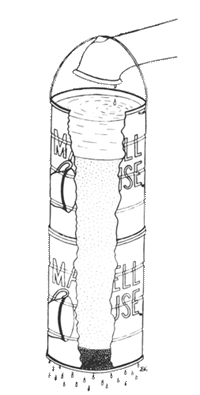The Ceiling is Up and the Floor is Down
by Gene Franks
A Rare Pure Water Occasional Book Review
As a foreign language student in college, long, long ago, I was impressed by the really important information you could get from foreign language textbooks. There were practice sentences that provided useful information like “The Rodriguez family is Mexican. They live in a Mexican house.” My all-time favorite was, “The ceiling is up and the floor is down.” That’s a bit of wisdom I have taken through life and have been able to apply to every building I ever entered.
Now that I mainly study water filtration equipment, there are two books, both written in English, that help me a lot. I use each of them almost every day. They are the Entingh Corporation’s Engineering Handbook and Alamo Water’s Water Improvement Engineering Guide.
The last mentioned was published by Alamo Water Refiners of San Antonio (the copyright date of my copy is 1991, but I have a feeling it goes back further). Alamo Water is now part of Watts Water Quality and Conditioning Products, but the AlamoEngineering Guide lives on. It is a 47-page fine print treasury of very useful information.
Here are some universal truths from the Alamo guide, so helpful they’re worthy of inclusion in foreign language textbooks:
If you want to avoid water hammer (and who doesn’t?), the size of your pressure tank should be limited to the

For bowling alleys, you should plan for 175 gallons daily usage per lane!
maximum GPM (gallons per minute) divided by 60 seconds times 2 seconds times 10.
If you want to install electrical equipment in a manhole, quarry or mine, submerged in water, you must conform to Nema 6 Electrical Enclosure Standards.
To use Birm to remove iron from water, the water’s Dissolved Oxygen (DO) content must be equal to at least 15% of the iron (or iron and manganese) content.
The Sphericity of Anthracite is 0.61 in loose pack format and 0.60 in tight pack.
When sizing a treatment system for a motel with 50 units, you should allow for 145 gallon per minute flow during peak demand if your toilets have flush valves. With flush tank toilets, 75 gallons per minute is enough.
For bowling alleys, you should plan for 175 gallons daily usage per lane.
If sizing a water system for an oil refinery, allow 80,000 gallons of water per day per 100 barrels of crude processed.
For taverns, plan on 20 gallons per day per seat.
A 2″ pipe will support a normal water flow of 65 gallons per minute but you can push up to 120 gallons per minute through it if you have to.
Barber shops need 55 gallons of water per day per chair.
Water boils at 212 degrees F. at 0 PSI pressure, but at 52 PSI it boils at 300 degrees F.
In dealing with boilers, you can convert pounds of steam per hour to horsepower by dividing it by 34.5.
Moderately hard water is defined as water with 3.5 to 7.0 grains per gallon hardness.
A 10″ X 54″ mineral tank (a common size) holds 1.5 cubic feet of filter medium or softener resin. It has a square foot media surface of 0.54 square feet, holds 0.45 cubic feet per inch of height, is 50″ tall to the sideshell, has a media bed depth of 34″ and a freeboard (empty space on top) of 16″. It supports a softener flow rate of 5.0 gallons per minute and a filter flow rate of 2.7. As a softener tank, it has as 45,000 grain capacity if salted at 22 lbs. per regeneration and 30,000 grains if salted at 9.

The Sphericity of Anthracite is 0.61 in loose pack format and 0.60 in tight pack?
A 30″ X 72″ mineral tank requires a gravel underbed of 200 lbs. of 1/4″ X 1/8″ gravel to support carbon filter media.
A circular brine tank, 20″ in diameter, holds 1.33 gallons of brine per inch of height.
The maximum operating temperature for Filter Ag is 140 degrees F.
Filox is effective between pH 5.0 and 9.0.
Weak acid cation resin is best at reducing alkalinity.
Vaseline or common grease should not be used on softener control valves.
The diameter of a human hair is about 75 microns.
The smallest bacteria measure about 0.2 microns.
It is advisable to feed a dealkalizer with softened water.
A cylindrical tank 3′ 2″ in diameter holds 58.92 gallons of water per foot of depth.
Manways on top of steel tanks can be either elliptical, flanged, davited, or hinged.
One of the popular manway styles is called a thief hatch.
Ductile iron has the strength properties of steel using casting techniques similar those of gray iron.
EPDM is made from ethylene-propylene diene monomer. It has exceptionally good weather aging and ozone resistance and is fairly good with ketones and alcohols.
A check valve installed near a pump in the discharge line will keep the line full and help prevent excessive water hammer during pump startup.
PVC has an excellent chemical resistance when used with fatty acids, but poly tubing is not recommended.
One gallon of muratic acid is equal in treatment capacity to 3.2 lbs. of hydrochloric acid.
One pound of polyphosphate typically treats 40,000 gallons of water at a 2 ppm concentration, but it is a good idea to slug the system initially at 10 ppm for 30 days to clean out the lines at a faster rate.
It takes 2 to 3 ppm chlorine with 30 minutes residence time to oxidize one ppm H2S.
One oz of calcium hypochlorite equals two level tablespoons.
To calculate the percentage rejection rate of a reverse osmosis unit subtract the product TDS from from the feedwater TDS, multiply by 100, then divide by the feedwater TDS.
SDI stands for Silt Density Index and it is a measurement of suspended solids in RO feedwater.
Watts divided by amps equals volts.
A gallon of water weighs 8.337 pounds.
To figure the gallon capacity of a reservoir, multiply the length by the width by the depth in feet. This gives the cubic foot total. To convert to gallons, multiply the cubic feet by 7.4805.
I could go on and on and on and on. The Alamo Water Improvement Engineering Guide has a million of them.
Editor’s Note: This article first appeared in the Pure Water Occasional for May 2010. –Hardly Waite.




![carbonpores1[1]](http://purewatergazette.net/blog/wp-content/uploads/2012/05/carbonpores11-300x186.jpg)
![oilybirds[1]](http://purewatergazette.net/blog/wp-content/uploads/2012/05/oilybirds1.jpg)


![web_edge0430sign[1]](http://purewatergazette.net/blog/wp-content/uploads/2012/05/web_edge0430sign1-300x220.jpg)
 The superintendent then explained how he could prevent diaper rash by building his own softener to use to wash his baby’s diapers.
The superintendent then explained how he could prevent diaper rash by building his own softener to use to wash his baby’s diapers.![primitivewatersoftener[1]](http://purewatergazette.net/blog/wp-content/uploads/2012/05/primitivewatersoftener1.jpg)



